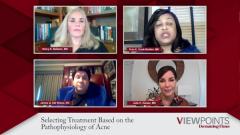
Unmet Needs and Future Direction of Acne
Key opinion leaders in dermatology share thoughts on unmet needs and the future direction of acne care.
Episodes in this series

Hilary E. Baldwin, MD: Let’s talk briefly about what’s coming up and if there are any other unmet needs or gaps that we need to fill. Jim, you always have your ear to the pipeline. What’s in our future?
James Q. Del Rosso, DO: There are a couple of interesting formulations that people are working on. There’s a sponge formulation, which I can’t say too much about, that people are working on. We also have to remember that we have some good over-the-counter formulations. We have a 5.5% benzoyl peroxide formulation that’s been proven to be as effective as a branded benzoyl peroxide–clindamycin formulation. It’s sometimes hard to get stand-alone benzoyl peroxide, so we have to remember that.
Hilary E. Baldwin, MD: What about the new microencapsulation of benzoyl peroxide and the possibility of combining it with tretinoin? How do you feel about that?
James Q. Del Rosso, DO: With the microencapsulation technology, you are correct: There is a microencapsulation technology that microencapsulates not just 1 big microcapsule but multiple small ones with different active ingredients as well. In the case of having the benzoyl peroxide 3% with a tretinoin in the same formulation, it had good efficacy in terms of the active vs the vehicle in clinical trials for acne once a day. That’s encouraging, so that’s going to be an important addition. There is also the combination formulation of topical minocycline foam with adapalene 0.3% that has completed its phase 2 trial, which is basically using the same as the 4% minocycline formulation as far as the vehicle. There’s a combination product in development with the topical minocycline and adapalene.
Hilary E. Baldwin, MD: A triple combination too, no?
James Q. Del Rosso, DO: Yes.
Hilary E. Baldwin, MD: We have a lot coming up. Julie, are there any unmet needs that you can think of? Are there things we still need to see?
Julie C. Harper, MD: There are always some unmet needs. The first would be that I would love to have an absolute cure for acne, especially 1 that does not have teratogenicity as a potential adverse effect. I would also like to give our patients easier regimens. Right now, things are once a day or twice a day, but if you look at the biologics in psoriasis, what’s happened is that we’ve gone from once a week to using the drugs every 12 weeks. If we had something in the acne world that was easier for our patients to be adherent with, that would be helpful. Those are the things that I would think of.
Hilary E. Baldwin, MD: When we’re talking about the future, the future is here today in telemedicine. Have you guys been using much telemedicine in treating your patients with acne? Fran, have you been doing that in your practice?
Fran E. Cook-Bolden, MD: Hilary, I have. During the beginning of the coronavirus pandemic, it was vital to shelter in place and focus on safety. Telemedicine took the front seat during that time, but it’s been helpful, and a lot of providers have continued it. I certainly have because there were still many people who were suffering from various forms of acne even during the pandemic. Telemedicine provides us a means for patients to consult with their providers, to be evaluated, and to start, continue, or adjust the therapy that they’re on. However, it’s not 3D, and I know that’s been 1 of the complaints of it: It doesn’t allow for the procedural interventions that we commonly do in acne. We can definitely guide our patients and make adjustments. I’ve found it helpful in allowing us to help our patients. I have continued to use it, and it’s not going to go away.
Hilary E. Baldwin, MD: It’s not going to leave my office anytime soon, especially for follow-up visits. Many people around the country have the advantage of having a parking lot for patients to come into. I don’t have such an advantage in Brooklyn. Parking is terrible, and being able to offer telemedicine for follow-ups is not going to leave my office any time soon. The patients seem to appreciate it. There was a bit of pushback to begin with, but they’re then acquiescent. Are you guys doing it in Nevada and in Alabama?
James Q. Del Rosso, DO: Our group is doing it. I have personally chosen not to take on tele-dermatology. We have some clinicians in the group who are doing it.
Hilary E. Baldwin, MD: Julie?
Julie C. Harper, MD: I have done it. I did it mostly during the 6-week shutdown period, and I was so thankful for my patients with acne at that time. I found my patients with acne and rosacea were the easiest to see via telemedicine. I’ve said on more than 1 occasion that there were some pluses. You could say, “I want to see the cream that you’re putting on your face,” and then they go with their phone or their laptop, and you’re going into their bathroom. They pick up the tube and say, “This is the 1.” It was nice to be able to do that, but we’re pretty open in Alabama, so I’m not doing much of it right now. The exception is for those patients who are in college, and they want to be able to do their follow-ups. Before, you’d always have to figure out when they are you going to be home, and we can now do a telemedicine follow-up visit. We’re certainly doing some, and I’m thankful for patients with acne because they’re the best patients to see by telemedicine.
Hilary E. Baldwin, MD: That’s true.
Fran E. Cook-Bolden, MD: In New York, you do a lot of driving, and as you mentioned, there’s a lot of difficulty with parking. Those patients find it helpful, and they are grateful.
Hilary E. Baldwin, MD: Nobody wants to get on public transportation.
Fran E. Cook-Bolden, MD: Absolutely, not unless you have to.
Hilary E. Baldwin, MD: Yes, exactly. We’ve pretty much rounded out the entire topic of acne. This has been an excellent discussion. We certainly hope you found this information to be valuable to your clinical practice. On behalf of my 3 good friends, I thank you all for watching this Dermatology Times® Viewpoints program. Have a great day.
Newsletter
Like what you’re reading? Subscribe to Dermatology Times for weekly updates on therapies, innovations, and real-world practice tips.























